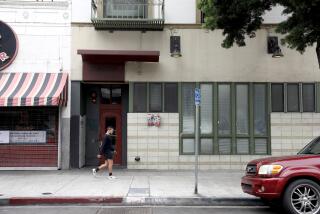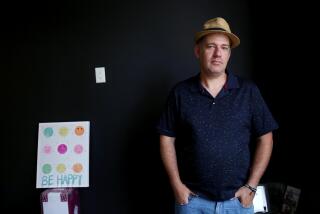Major Eastside Redevelopment Project Will Have to Wait Longer
The planned sale of a major redevelopment project in Boyle Heights is raising concerns that the affordable housing and retail outlets that the area needs may be delayed.
Santa Monica-based real estate firm MJW Investments is expected to formally announce today that it is soliciting proposals from buyers to purchase its 23-acre site at Olympic Boulevard and Soto Street.
The site, home of a long-shuttered Sears, Roebuck & Co. distribution center, is a landmark in East Los Angeles and one of the city’s largest redevelopment projects in recent years.
The project’s proposed addition of condominiums, apartments, stores, offices and restaurants would provide an economic spark for the area, possibly making it less affordable for the community’s lower-income residents. As such, the project could add to a growing problem facing many lower-income communities whose real estate prices have surged with the five-year housing boom -- in some cases rising faster than in more-affluent areas.
The mixed-use project would have taken five to seven years to complete even under the current owner.
But now the process of finding a buyer and completing the transaction could delay the redevelopment even further, community leaders say. They also express concern that a new owner may not have the community’s best interests in mind.
“We now have to expedite the process,” said Los Angeles City Councilman Jose Huizar, whose district includes Boyle Heights. “The community’s been waiting too long.”
Huizar and Mayor Antonio Villaraigosa expressed their commitment to the effort.
“The mayor believes this is an important signature site and he is very committed to making sure that it is redeveloped in an appropriate way,” said Diana Rubio, a spokeswoman for the mayor’s office. “The biggest interest is in retail because the neighborhood is so underserved by retail.”
MJW President Mark Weinstein said the company had been flooded with calls from potential buyers about the development, indicating a great amount of interest. He said MJW would work with the new development firm to ensure that the initial vision stayed the same.
“We’re open-minded to how we’ll be involved,” he said.
Weinstein said he didn’t have a minimum asking price and would wait to see the bids.
The new developer will have to determine which structures at the site to convert to new uses and which to tear down and replace.
With more than 1 million people living within a five-mile radius of the site, the need for more retail space and housing units continues to be pressing, Huizar said.
The site also is of historical value to the Boyle Heights community. The nine-story, 1.9-million-square-foot Sears building has long been an icon for Angelenos, said Ken Bernstein of the Los Angeles Conservancy. The distribution center once served as an important mail-order fulfillment center for the company.
“It’s clearly one of the great visual icons of the entire Eastside of Los Angeles,” Bernstein said. “Its tower is a very visible beacon from the jumble of freeways that really bisect Boyle Heights.”
MJW’s Weinstein said the company would ease the transition to new owners by providing information from the many community meetings in which the firm had participated.
His firm purchased the property in 2004, envisioning a $450-million project with housing and 660,000 square feet of stores, offices and restaurants. After paying $40 million for the property and investing an additional $10 million in the project, the firm decided to sell the property because it did not align with its business plan of focusing on short-term ventures, Weinstein said.
When it was first slated, the MJW project met with resistance from community leaders concerned that the new housing would drive up prices in the surrounding area. But meetings including developers, city planners and residents helped assuage fears that the area would succumb to gentrification.
As the property is put up for sale, residents and community activists fear that new buyers may not be as amenable to input from nearby stakeholders.
“We know that MJW was willing to come to the table and participate in community meetings that really, truly engaged people,” said Maria Cabildo, executive director of East Los Angeles Community Corp., a nonprofit community development organization. “I have concerns about who else might be interested in this property.”
Gaining the community’s trust again may be a challenge for the next investor, said Frank Villalobos, president of Barrio Planners, an architecture firm in East Los Angeles.
“Is the community going to believe the next guys that come around with their carpetbags?” Villalobos said.
The real estate market has changed since MJW bought the property. With more than 400 affordable-housing units lost to housing project renovations, the extension of County-USC Medical Center and the Hollenbeck police station replacement, finding an affordable place to live in Boyle Heights has become increasingly difficult, community leaders say.
“We’re really on the verge of changing as a community in a very dramatic way,” Cabildo said. “We have families coming in on a regular basis that are facing huge rent increases -- those things weren’t happening when the Sears project first came up.”
The median price of a single-family home in Boyle Heights hit $395,000 in April, up 27.4% from the same month last year, according to DataQuick Information Systems, a La Jolla-based research firm. By contrast, the median price for single-family homes and condominiums in all of Los Angeles County was up 13.6%.
Cabildo said she was also concerned that the new developers might consult primarily with homeowners -- “an anomaly on the Eastside” -- and could forget renters.
“People aren’t used to consulting with renters, thinking they are only here for a temporary basis, but we have renters that have lived here for two, three decades,” she said. “They’re not transient. They stay here for generations.”
The circumstances may make it more difficult for a developer to construct a mixed-income housing project and still make a decent profit in the area, said Ralph Carmona, an economic development advisor to the board of the Boyle Heights Chamber of Commerce.
After seeing MJW’s success with projects such as Santee Court in downtown Los Angeles, a series of garment-district buildings converted into luxury lofts, some are disappointed at the firm’s decision to leave the project.
“I’m sad that [Mark Weinstein] is pulling away, to tell you the truth,” Villalobos said. “He was offering mixed-use development with the luxury trimmings of his apartments downtown.”
More to Read
Inside the business of entertainment
The Wide Shot brings you news, analysis and insights on everything from streaming wars to production — and what it all means for the future.
You may occasionally receive promotional content from the Los Angeles Times.










